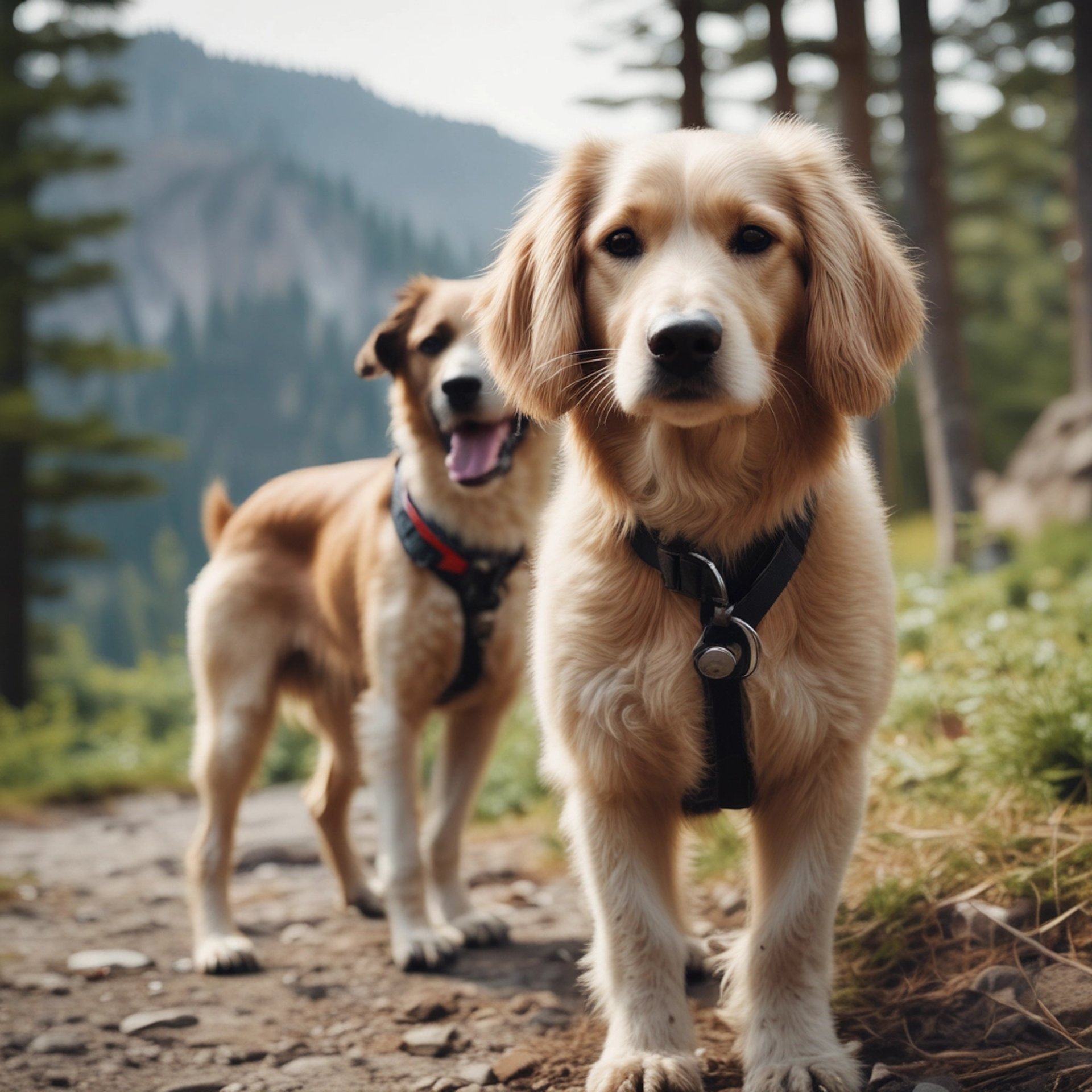
Introduction to Rucking with Your Dog
Rucking, a term derived from military training, refers to walking or hiking while carrying a weighted backpack. This exercise not only improves overall fitness but also adds an element of challenge through the additional weight. The simplicity of rucking makes it an accessible option for fitness enthusiasts of all levels, and when combined with dog walking, it transforms routine outings into dynamic workouts that benefit both owner and pet.
For pet owners, integrating rucking into daily dog walks allows one to elevate their physical activity significantly. By carrying weights, individuals can increase their strength, endurance, and cardiovascular fitness while enjoying quality time with their furry companions. Dogs, being naturally energetic and social animals, thrive on regular walks, and rucking offers a stimulating variation that can keep them engaged. The added weight encourages owners to maintain a steady pace and longer duration during walks, ultimately resulting in enhanced benefits for both parties.
The growing popularity of rucking within the pet owner community is a testament to its effectiveness and enjoyment. Many are discovering that traditional dog walking can become monotonous, and by adding a rucksack filled with weights, the experience turns into a productive exercise session. This trend is supported by various fitness groups encouraging outdoor activities with pets, highlighting the feasibility of improving physical health while nurturing the bond between dog and owner.
Furthermore, rucking aligns perfectly with the desires of health-conscious individuals, as it can be easily tailored to suit personal fitness goals. From weight management to muscle toning, rucking with a dog can cater to a wide array of objectives, allowing for versatile training opportunities. In essence, participating in this activity fosters a healthier lifestyle while simultaneously providing physical and mental stimulation for the dog, ensuring a rewarding experience for both the pet and the owner.
The Benefits of Rucking for You and Your Dog
Rucking, an outdoor activity of walking or hiking with a weighted backpack, offers numerous physical and mental benefits for both you and your dog. Engaging in this exercise nurtures cardiovascular health, builds strength, and increases stamina, effectively working out both human and canine bodies. By incorporating rucking into your routine, you can help maintain a healthy weight, improve your heart rate, and enhance overall endurance levels.
For humans, the physical challenge of carrying a weighted load while walking promotes cardiovascular fitness by elevating the heart rate, strengthening heart muscles, and improving circulation. Additionally, rucking serves to enhance muscular strength and endurance. As a compound exercise, it engages a variety of muscle groups in both the legs and core, providing a full-body workout. This adaptation supports the body in becoming more efficient during daily activities and recreational pursuits.
Similarly, dogs benefit from rucking as it provides them with the opportunity for rigorous exercise, essential for weight management and muscle development. Regular engagement in this activity can combat canine obesity and support joint health, ensuring your dog remains active and vibrant throughout their life. As they navigate varied terrain, dogs will also experience increased mental stimulation, which is vital for their cognitive health.
Beyond physical attributes, rucking fosters a unique emotional connection between you and your dog. Exercising together amplifies feelings of joy and companionship, creating a shared experience that can motivate you to push your limits. Pets often serve as a source of encouragement; their enthusiasm can inspire you to continue through challenges, enhancing your mental resilience and overall happiness. This bond allows both you and your dog to thrive, making your rucking adventures more rewarding on multiple levels. Ultimately, rucking stands out as a holistic approach to health, offering profound benefits for both you and your canine companion.
Choosing the Right Gear for Rucking with Your Dog
When engaging in the rewarding activity of rucking with your dog, selecting the appropriate gear is paramount to ensuring a safe and enjoyable experience for both parties. At the core of this selection lies the backpack, which should ideally combine comfort and functionality. Look for a well-fitted, durable ruck sack that allows for a smooth weight distribution while accommodating enough space for your dog's necessities, such as water, food, and first aid supplies. A well-structured backpack not only supports the load but also maintains ergonomics to reduce strain during long ruck sessions.
Equally important is the choice of a harness for your dog. Opt for a high-quality, adjustable harness that promotes comfort and allows for freedom of movement. A harness designed specifically for rucking can be beneficial, as it distributes pressure evenly across your dog's body. This equipment is crucial, especially if you encounter rugged terrains, where your dog may need additional support. A strong and secure harness is necessary to keep your dog safe and ensures you maintain better control during your rucks.
Your leash selection also warrants attention. Depending on the environment, a shorter, more robust leash can provide better control and prevent tangling during rucking on challenging pathways. A leash designed with reflective materials will further enhance visibility during low-light conditions, adding an element of safety. Furthermore, choose footwear that offers both traction and comfort. Supportive hiking shoes or boots can mitigate risks of slips and blisters, while also providing adequate ankle support when traversing uneven ground.
In essence, investing in suitable rucking gear for both you and your dog enhances the experience by fostering safety and comfort, allowing you to focus on enjoying the journey together, regardless of the terrain or conditions encountered.
Training Your Dog for Rucking Adventures
Preparing your dog for rucking is not only essential for a successful outing but also crucial for their overall well-being. The training process involves several effective techniques to build endurance, acclimate them to a rucking pace, and ensure they are physically fit. Start by conducting a general health check to ensure your dog is fit for exercise, and consult your veterinarian if necessary. Once cleared, introduce short rucking sessions gradually, as this helps in adjusting their fitness levels without the risk of injury.
To build your dog’s endurance, begin with brisk walks or light jogs, gradually increasing the duration and intensity. Focus on varying terrains; uneven surfaces will mimic the conditions encountered during rucking. Incorporating activities such as fetch or agility training can also contribute to their stamina. When your dog shows signs of fatigue, it’s crucial to rest and hydrate, emphasizing the importance of monitoring your dog’s physical condition throughout the training process.
Introducing your dog to the rucking pace requires patience. Equip them with a harness or a well-fitted dog backpack containing gradually increasing weights. This will help simulate the rucking experience while ensuring your dog becomes accustomed to carrying their load. Start with lightweight, familiar objects and progressively increase the weight as your dog adapts. Regular practice walks at a controlled pace will help establish a comfortable rhythm for both you and your dog.
Monitoring your dog’s reaction to the added weight is vital to prevent discomfort and strain. Always prioritize your dog’s comfort and safety, adjusting their load based on their size and fitness level. Remember to gradually increase the distance of your rucking sessions, ensuring that your canine companion remains engaged and excited about your adventures together. With consistent training, your dog will be ready to enjoy the exhilarating experiences that rucking has to offer.
Making the Most of Your Rucking Experience
Engaging in rucking with your dog is not just a physical activity; it’s an opportunity to bond and enjoy the outdoors together. To enrich this experience, it is essential to implement strategies that will keep both you and your canine companion motivated and enthusiastic. One effective approach is to incorporate regular breaks into your rucking schedule. These pauses allow you to recharge while ensuring your dog remains comfortable and hydrated. Frequent stops also provide an opportunity to enjoy the scenery, strengthening your connection with nature and each other.
Changing routes is another way to maintain excitement during your rucking sessions. Exploring different trails can offer diverse experiences, both visually and physically. Not only does this variety stimulate your dog's curiosity, but it also helps you avoid monotony, keeping your motivation intact. Trails with varying terrains present a natural challenge, promoting both cardiovascular fitness and endurance for you and your dog alike. Whether it’s a lush forest path, a rocky hillside, or a sandy beach, the diversity of environments can truly enhance your rucking experience.
Moreover, monitoring your performance and your dog’s well-being is crucial, especially during longer outings. Pay attention to your energy levels and adjust the intensity of your ruck as needed, ensuring you don’t overexert yourself. For your dog, keep an eye on signs of fatigue or distress, such as excessive panting or reluctance to continue. Regular pauses for water and rest will not only prevent overheating but also ensure that your dog remains a happy and willing participant throughout the adventure. Additionally, be aware of the weather conditions, as extreme heat or cold may necessitate shorter rucking sessions to prioritize safety.
Safety Considerations While Rucking with Dogs
Engaging in rucking with your canine companion can be a rewarding experience, yet it is essential to prioritize safety for both you and your dog. One of the most critical aspects of ensuring safety during rucking is maintaining proper hydration. Dogs, like humans, can suffer from dehydration, particularly during extended physical activity. Always carry enough water for both you and your dog, and take regular breaks to allow your dog to rehydrate. Watch for signs of excessive thirst or panting, which can indicate the need for immediate hydration.
Moreover, it is crucial to recognize symptoms of fatigue and heatstroke, especially in warmer weather. Common signs include excessive panting, drooling, disorientation, or a sudden decrease in energy. If any of these symptoms arise, it is vital to stop the activity immediately and find a shaded area for your dog to cool down. Applying cool, wet cloths to areas such as the dog’s neck and paw pads can help alleviate overheating. Additionally, be aware of the terrain; hot pavement can cause burns on sensitive paws, making trail selection important.
Training is another fundamental aspect of rucking safely with dogs. Ensuring that your dog responds well to commands in outdoor settings will prevent dangerous situations. For instance, having your dog "leave it" or "come" can protect them from potential encounters with wildlife or other pets. Always remain vigilant for hazards, such as steep drops or particularly rugged terrain, which could pose risks to you and your dog alike. By anticipating possible dangers and preparing accordingly, you can enjoy a safe and fulfilling rucking experience with your dog.


